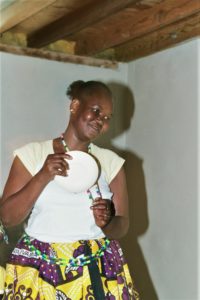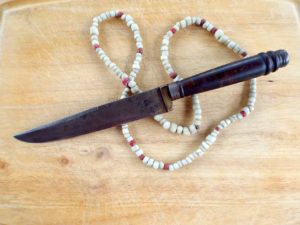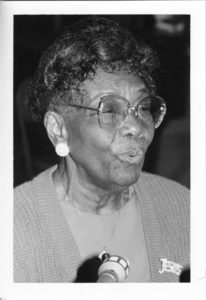200 Stories for Missouri’s Bicentennial, May 2021
200 Stories, May 2021
#ShowMeFolk #200Stories #Missouri2021 #Missouri200
In Missouri’s bicentennial year, Missouri Folk Arts will share 200 stories over the course of 52 weeks in 2021 about folk and traditional arts in the Show Me State.
We kicked off May with Story 66 and wrapped up with Story 80.
66 of 200
Kicking off Ava, Mo. Week
Edna Mae Davis, TAAP master artist: 1988, 1989, 1990, 1991, 1993
Edna Mae Davis (1929-2003) was a leader in the twin traditional arts of Ava, Missouri—old-time music and dance. Mrs. Davis is remembered fondly as a square dance caller and dancer. From age three, she found herself participating in the festivities of her small town. “That was all we did in our community,” she once wrote on her application for the Traditional Arts Apprenticeship Program. These traditions were steeped in her family, too, those who preceded her, grew up with her, and those who continue to this day. When Edna Mae Davis wasn’t dancing and calling, she was preparing future Ava youth in her family (including daughter Cathy) and neighbors to continue the traditions. Davis is one of Mo Folk Arts’ Master Artists/Master Teachers—a master artist who taught in five or more years of TAAP.
Charlie Walden recorded a dance party in Ava in 1997, digitized and posted several dances to YouTube in 2015. We’ve weeded through all 21 to find the best view of Edna Mae Davis, as she’s often in the background calling and helping dancers make their turns. In the linked video, she is dancing to “Put Your Little Foot” on April 24, 1997. She’s in the yellow top and white slacks dancing with Cathy, then her brother Lawrence. We also spy granddaughter Jody and sister Evelyn Pulliam in this video, too.
http://https://youtu.be/ap-thkPLARE
67 of 200
Bob Holt, TAAP master artist: 1988, 1989, 1990, 1992, 1993, 1994, 1998, 1999, 2000, 2001
Bob Holt (1930-2004) helped define Ava, Missouri’s regional old-time music and dance tradition. He once wrote: “I grew up as the only fiddler in a large family of good dancers and probably learned as much about playing dances from them as I ever did from any fiddlers.” When teaching apprentices (he led ten apprenticeships), Mr. Holt strongly encouraged his students in TAAP and beyond to cater to the dancers. Legend has it, that part of his apprenticeship required his students to dance as well as fiddle.
Holt was so well-regarded for his skill and legacy that the National Endowment for the Arts awarded him a National Heritage Fellowship in 1999. Holt and two back-up musicians performed at the Heritage Fellow concert in Washington, D.C., and eight Ava square/jig dancers and caller Edna Mae Davis joined them on stage to illustrate the intertwining of the twin traditions.
Shortly thereafter, the West Plains Council on the Arts established the Annual Bob Holt Jig Dance Competition at the Old-Time Music, Ozark Heritage Festival. How many musicians get a dance contest named for them? This year’s contest is scheduled for Saturday, June 5, 2021 at 2:00 p.m. Festival attendees should expect to see Holt’s former apprentices perform over the weekend, as well.
Learn more of Bob Holt’s story at the Masters of Traditional Arts’ website, and catch the short video clip from the 1999 Heritage Fellowship Concert at the link.
68 of 200
Alvie Dooms, TAAP master artist: 1991, 1992, 2000
Alvie Dooms is yet another anchor in Ava, Missouri’s old-time music and dance traditions. For years, he backed up his good friend, fishing buddy, and cousin-by-marriage Bob Holt. Dooms, too, traveled to Washington, D.C. to back Holt at the 1999 National Heritage Fellow Concert. Since Holt passed away in 2004, Dooms has remained as constant on the Ozark old-time music scene as the rhythm he provides at dances and jams. In a typical year, when he’s not fishing or repairing an instrument, Alvie Dooms is playing guitar weekly at McClurg Jam and annually at the Old-Time Music, Ozark Heritage Festival. Often he’s backing David Scrivner, one of Bob Holt’s last apprentices.
Honestly, it’s hard to choose a link to share Mr. Dooms’ story. Google him, and you’ll see. One good link to share is embedded in an Oldtime Central interview with David Scrivner in which the fiddler acknowledges how Dooms kept and keeps him engaged in the tradition, and in their friendship. https://oldtime-central.com/david-scrivner-interview-tunes/
69 of 200
Cathy Davis Marriott, TAAP master artist: 1996, 2008
Cathy Davis Marriott, daughter of Edna Mae Davis, has and is working hard to keep those Ava, Mo. traditions alive in the region and in her own family. As a master artist, she taught family members, including her own daughter Jody. Edna Mae, Cathy, and Jody all have noted that they learned to dance around age three. Their social lives as children and then adults usually involved attending old-time dances on the weekends, and they often attended Bethel Fiddle Camp during summer vacations.
Now, Marriott continues her deep involvement in the old-time scene. She and her husband (champion fiddler Jr. Marriott) are raising their own accomplished young fiddlers. And, Cathy Marriott continues to promote old-time square and jig dancing, including at the Old-Time Music, Ozark Heritage Festival. On June 5, she will emcee the Bob Holt Jig Dancing Competition, focusing on the regional solo dance tradition at which Cathy Marriott excels.
There’s not much better than watching Marriott partner and jig with her uncle, the late Lawrence Schuler, with Edna Mae Davis calling in the background in another video from the April 1997 dance in Ava recorded by Charlie Walden. (Cathy Davis Marriott is in the blue tshirt, jeans, and white tap shoes.)
http://https://youtu.be/f_fymnXgXow
70 of 200
Thomas Verdot, TAAP master artist: 2016, 2021
Thomas Verdot (Columbia) is yet another TAAP artist whose interest was piqued by tradition as a child. He started violin lessons at age 8 and worked in his father’s shoe repair business, where Mr. Verdot learned to work with his hands. Those two skills met in his desire to learn instrument repair, a service he offered to old-time and bluegrass musicians.
At age 40, he sold the family business to pursue luthiery–repairing, restoring, and building stringed instruments from scratch. He traveled and studied under two renowned master luthiers. In turn, he has taught others, including two apprentices in Missouri’s program: Will Scherer (who studied with Verdot for seven years, including one in TAAP) and now Vanessa Markley, who visited Verdot in 2019 for violin restoration and ended up staying to learn how to do the job herself. Fun fact: she, too, started playing violin at a young age, then pursued old-time music via the Bethel Youth Fiddle Camp in Shelby County.
Back in 2008, a Columbia Missourian reporter wrote a profile of Mr. Verdot, then age 54: “A Virtuoso of Violins.” Read more about his story at the link.
71 of 200
Ann Pittman, TAAP master artist: 1990, 1991, 1992
Mrs. Ann Vasily Washington Pittman (1908-2009) was a three-time TAAP master artist. She was particularly known as a singer of spirituals and a traditional storyteller, as well as a self-taught folklorist and documentarian. Mrs. Pittman grew up in Yalobusha County in Mississippi and later moved to St. Louis as a young adult. Her interest in preserving the songs and stories she grew up hearing was sparked in 1967 when she went to visit her mother. One morning, she woke up to hear the familiar sound of her mother singing. She dedicated herself to writing down and recording hymns, spirituals, and slave songs that matriarchs shared during her childhood in Mississippi.
In addition to her participation in TAAP, Mrs. Pittman performed often throughout the state. In the seventies, Missouri Friends of the Folk Arts worked with her to record and produce four cassettes called “Imitations of Mother,” and copies are deposited at the American Folklife Center at the Library of Congress. Additionally, scholars Rosemary Thomas and Debra Foster Greene recorded and documented aspects of Mrs. Pittman’s narrative history for posterity, archived at the The State Historical Society of Missouri.
Photo of Mrs. Ann Vasily Washington Pittman from the Missouri Folk Arts Program’s archives.
72 of 200
Folk School of KDHX, Missouri Arts Council Folk Arts Grantee
The Folk School of KDHX was founded in 2001 and “dedicated to renewing and expanding folk music in St. Louis.” To do so, the folk school coordinates lessons, jams, workshops, and festivals to engage traditional musicians and audiences in genres like old-time, bluegrass, jazz, swing, and folk music.
As we all know, those kinds of events were stalled necessarily in 2020 and into 2021. Folk School of KDHX shifted gears these last several months, providing free “Saturday Sessions,” weekly lessons in these genres with master musicians on an array of instruments: fiddle, banjo, guitar, uke, dulcimer, mandolin and more. And, all those lessons are archived right here on Facebook! https://www.facebook.com/watch/folkschoolofkdhx/?ref=page_internal
So many choices! Maybe try a little old-time harmonica lesson with Willi Carlisle from January. https://fb.watch/5Sbd7KentX/
73 of 200
Mirjana Grill, TAAP master artist: 2010, 2014 Mirjana Grill (d. 2018) grew up in Zenica, Bosnia-Herzegovina, where she traced her love of “sevdah” to her early childhood–from “the cradle” and recalled starting to sing in the tradition herself at 5 or 6 years old. She remembered an older sister and several other family members singing sevdah, while others accompanied the singers on guitar, accordion, and tamburica. Sevdah, she told us, are what we might call “love songs” or “love ballads” in English,” typical of courting rituals dating back to the 16th century.
Like many others from her homeland, she immigrated to St. Louis following civil war, working hard to resettle in her new country. In St. Louis, she and other friends eventually found the time to sing and play their traditional music again, and to establish St. Louis Sevdah, a non-profit organization that celebrates and sustains the tradition. In the video below, she performs during a sevdah festival in St. Louis.
http://https://youtu.be/eoHd35JKrJI
74 of 200
Robert Reed, TAAP master artist: 1996
Robert Reed (1957-2015) found love for tap after watching films featuring the “Four Step Brothers” that included his grandfather and mentor, the iconic dancer Maceo Anderson. As a young man man, Mr. Reed set out from St. Louis to Las Vegas in 1982, where he worked hard to learn both tap dancing and acrobatics. Later, Mr. Reed toured the U.S. with the Cab Calloway Orchestra before returning to St. Louis. Settled back home, he established his non-profit organization, the Robert L. Reed Tap Heritage Institute. There, Reed solidified himself as a dancer, teacher, producer, and director of one of St. Louis’s most popular and long-lasting festivals, the St. Louis Tap Festival.
Check out this 2010 video where Mr. Reed teaches a few Four Step Brothers’ steps.
http://https://youtu.be/t-alsz6ZdUk
75 of 200
Nermin Fazlic, TAAP master artist: 2005
Nermin Fazlic came to the U.S. as a first-generation refugee, escaping civil war in his home country of Bosnia. There, he was the choreographer in his village before his family fled the atrocities of war. Teaching traditional dance was a job he did not forget upon resettling in St. Louis, and he began teaching his son Haris Bosnian folk dances at age six. St. Louis is home to one of the largest Bosnian communities outside of Bosnia itself, and Mr. Fazlic drew on community support in St. Louis to unite and continue the traditions of their home country. In 2002, he founded Bosanko Kolo, the only Bosnian dance troupe in St. Louis at the time, and he served as the teacher, choreographer, and leader.
The traditions the elder Fazlic instilled in his son are evident in the ways the young man wove Bosnian tradition into his academic and professional pursuits. In a 2015 feature article from the Columbia Missourian, the reporter weaves the stories of Nermin, Haris and their dance traditions throughout the story.
https://www.columbiamissourian.com/news/local/mu-student-expresses-love-for-dance-song-and-bosnian-culture/article_13ead383-ebe5-5ef4-80d5-c9c4c7d5ab30.html
76 of 200
Mary Luka Kemir, TAAP master artist: 2005
Mary Luka Kemir represents another group of newcomers to Missouri, the Kuku of South Sudan who also south refuge due to civil unrest in their homeland. Ms. Kemir and her community actively strive to remain tight knit and to practice traditions like their the songs and dances, especially the Bola song/dance that is vital to celebrations and milestones.
In her apprenticeship, Kemir focused on six dances/songs with her primary apprentice Dina Yakata, as well as several other young women whose interest was sparked by the lessons. Three of the songs are tied to weddings, and three are tied to naming ceremonies. Kemir and Yakata came together for their lessons in the basement of their church in Kansas City, where they were joined by several members of their Kuku community who played percussion, sang, and danced in ways akin to what they knew at home in South Sudan. Percussion is key in the Bola tradition with drums as well as hand clapping, footwork, and (as seen in the photo) scraping saucers against beaded necklaces.
Photo description: Master artist Mary Luka Kemir observes and accompanies dancers by scraping a saucer against her beaded necklace in the basement of their church in 2005. Photo credit: Deb Bailey

Master artist Mary Luka Kemir observes and accompanies dancers by scraping a saucer against her beaded necklace in the basement of their church in 2005. Photo credit: Deb Bailey
77 of 200
Bennie Smith, TAAP master artist: 1995, 1997
Bennie Smith (1933-2006) was a St. Louis native and musical genius, widely recognized as one of St. Louis’s leading blues guitarists. His technical mastery of the instrument and innovative arrangements of several blues classics earned him the title “Dean of the St. Louis Electric Guitarists.” As a child, Smith first tried his hand at the ukulele, then gave it up for guitar when he was a pre-teen. Throughout the 50s, Smith spent much of his time listening to musicians on the radio and learning guitar from people around his neighborhood.
Over the years, Bennie Smith played as a side man for B.B. King, Little Milton, Aretha Franklin, and Ike Turner. In fact, Smith played guitar in 1958 on Turner’s “Box Top,” with background vocals by Little Ann (later known as Tina Turner). From 1991-2006, Smith released three albums of his own and is remembered still as an icon and inspiration in the St. Louis blues scene. Read the transcript of a 1996 interview with Smith here: https://www.stlblues.net/smith.html 1996 radio interview
Then, check out this tribute posted to YouTube, including apprentice Sharon Foehner, memorializing Smith.
http://https://youtu.be/HK52AKU1ZxY
78 of 200
Mildred Whitehorn, TAAP master artist: 1995 (vocals), 1996 (hair braiding)
Mildred Pulliam Whitehorn, born in Hayti, Mo., was the granddaughter of sharecroppers. Her father worked both as a welder–and pastor, so music was young Mildred Pulliam’s destiny. Family members, key influences, enjoyed singing both gospel and blues. Her first solo took place in church at 6 years old. As a young woman, she sang with a rock band before going solo under a pseudonym. “Veda Brown” released solo records and singles under contract with the iconic Stax Records in Memphis, Tennessee.
After Stax fell on challenging times, Mildred returned home, married, and started a family and her career as a cosmetologist. She also prioritized sacred music as a gospel singer and award-winning choir leader. Whitehorn continued to perform and teach gospel music in the Bootheel area, while also styling and braiding neighbors’ hair.
Previous Missouri Folk Arts director Dana Everts-Boehm published an extended essay on Mildred Whitehorn and the Bootheel’s gospel tradition in 1995, available as a PDF here: https://mofolkarts.missouri.edu/…/2017/05/gospel.pdf
79 of 200
Mary Fritz, TAAP master artist: 2004
Mary Fritz (Berger, Mo.) is widely recognized locally as a master gardener, and she has practiced and sustained the “four-square” gardening tradition. In Franklin County and along the region near the Missouri River, traditions from German immigrants persist. The practice of four-square gardening is, however, one of the lesser-known traditions practiced in the area and one that has waned considerably. Mrs. Fritz has served as a tradition bearer, keeping, demonstrating, and passing on something she learned from her mother, who learned them from her mother.
For a full explanation of the tradition and more about Mary Fritz, check out the essay penned by Missouri Folk Arts Specialist Deb Bailey in 2005 for the Max Kade Institute for German-American Studies at the link:
https://mkifriends.org/…/uploads/2015/02/mkisummer05.pdf
80 of 200
Glen Mock, TAAP master artist: 2017
Glen Mock (1950-2020) liked to blacksmith and specifically to make knives on the ranch he and his wife shared in Mercer. In his TAAP application and interviews, he recalled a desire to learn the tradition, one he only took up in 2010, during lessons with Herschel and Frank House, the former a master artist in Kentucky’s apprenticeship program. While Mr. Mock started knife making later in life, he long practiced blacksmithing, silversmithing, and scrimshaw carving, all of which influenced his well-regarded knives.
Mr. Mock also noted that he and his wife enjoyed living off the land they purchased in 1978. He was easily recognized in town and beyond for donning western attire daily and driving into town by horse and buggy regularly. While his life and his art were grounded in history, Mock also was proud of his innovations: “I have a love of knives from the 1800’s in particular. Some people want exact copies of particular knives made long ago. I much prefer to draw on knife traditions and patterns of the past but make them my own.”

Glen Mock submitted this image of one of his knives as support for his application to the Traditional Arts Apprenticeship Program. Courtesy of artist.

